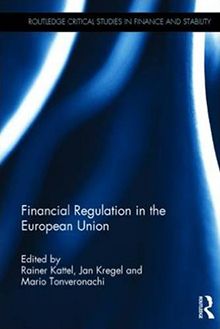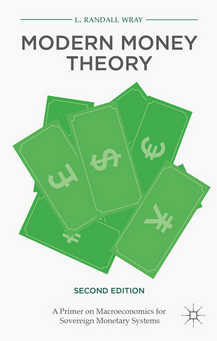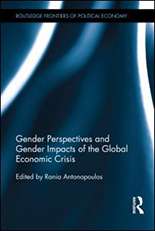
Research Topics
Publications on Political economy
-
That “Vision Thing”: Formulating a Winning Policy Agenda
Public Policy Brief No. 158 | March 2025In recent elections, Republicans and Democrats have been competing for the votes of the suburban middle class. The pocketbook issues of the working class have been largely ignored by both parties—this group comprises the true swing voters (voting for Trump in 2016 and 2024 and for Biden in 2020), but their votes are largely protest votes, against incumbents who have not delivered for them. In this policy brief, Institute President Pavlina R. Tcherneva and Senior Scholar L. Randall Wray examine the shifting allegiances of American voters and the types of policies they favor. Tcherneva and Wray are primarily interested in the types of economic policies that would improve the well-being of American working class families and outline some of the economic policies that could win this group over for the next election. As the authors note, while not every “popular” policy is a good policy, good progressive policies are far more popular with the electorate than is typically recognized by either party.Download:Associated Program:Author(s): -
Trump Wins While Americans Vote for Progressive Policies
Policy Note 2024/3 | November 2024On November 5, 2024, American voters sent Donald Trump back to the White House. In 2020, he lost his bid for reelection to Joe Biden, after winning in 2016 against Hillary Clinton (but only thanks to the electoral college). This time, however, Trump won the popular vote. All the new energy that surrounded the Harris-Walz campaign was outmatched by the turnout from Trump supporters.
All polls—whatever one’s feelings about their reliability—kept pointing to the same defining issue in this (as in every other) election: the economy. Critical issues of democracy, abortion, and immigration filled the airwaves and political speeches, but the economy remained once again more powerful than any one of them.
Economists uniformly failed to grasp what these “concerns with the economy” were all about. They kept celebrating the decline in inflation and kept pointing to the fastest recovery in postwar history. The labor market—almost everyone declared—was now at full employment (a few of us strongly disagreed). Real wages, especially at the bottom, had finally risen for the first time in many decades. Fiscal policy had returned, juicing up economic growth with mega-contracts to firms and generous credits for renewable energy: all developments we hadn’t seen in decades.
This was an economy that most economists hadn’t seen in their professional lives. For 50 years, wages had been stagnating, jobless recoveries were the norm, labor force participation rates were falling. This time was different: the fastest recovery from any postwar recession, growth rates America hadn’t experienced in decades, prime-age employment at its historical peak, record peacetime government spending, and wage increases at the bottom of the income distribution. This time the recovery felt different. But despite the post-COVID splurge to salvage and repaint the old American economic engine, for many families it was the same old clunker under the hood.
And this is exactly what the various ballot measures on election night seemed to tell us. When presented with questions about the economy and their standard of living, voters expressed their displeasure with how things were going and they voted in support of pro-worker measures—especially in red states.
Here are some of the ways in which state ballot measures played out.
Paid Sick Leave
Three states had introduced measures requiring employers to provide paid sick leave to workers (Alaska, Missouri, Nebraska). In all three states, these measures passed. All three states voted for Trump.
The United States is the only advanced country without a federally mandated paid leave policy.
Minimum Wages
When it came to wages, Alaska and Missouri passed measures to increase their minimum wage to $15/hour (in 2027 and 2026, respectively) and adjust them with the cost-of-living thereafter (a similar measure had already passed in Nebraska in 2022). A fourth state (Arizona) rejected a proposed measure to reduce wages of tipped workers.1 Arizona, too, voted for Trump.
In California, a minimum wage ballot measure (Prop 32), which would have raised the minimum wage to $18/hour, was rejected. It is unclear why, but CA voters had already passed a law in 2023 to raise the minimum wage to $16/hour in 2024.2 Massachusetts had proposed an unusual and generous increase in the wages of tipped workers (to reach 100 percent of the MA minimum wage by 2029—while continuing to earn tips), but that ballot measure was also rejected. While none of the existing or proposed minimum wages are living wages, it seems some red states are catching up to increases that have been happening in blue states.
Infrastructure, Climate, Health
In California,3 two infrastructure investment measures passed. Prop 2 authorizes a bond issue to go forward for public school and community college facilities, while Prop 4 is another bond issue for the support of water infrastructure, wildfire protection, and addressing climate risks.
CA also passed a measure regulating how federal money from drug reduction programs would be spent (Prop 34). Voters wanted 98 percent of such funds to go directly to patient care.
Housing and Prison Labor
What CA voters also wanted is to retain oversight over such bond issues, and therefore they defeated Prop 5, which reduced the votes needed to approve bond issues for housing and other public infrastructure from the current two-thirds majority to 55 percent. CA also rejected a measure to expand rent control (Prop 33) and a measure (Prop 6) that would have banned forced servitude (i.e., using prison labor as punishment). Prop 6 would have made prison labor voluntary and would have prioritized rehabilitation.
School Choice
Three states introduced a measure to amend the state constitutions and allow state money to go to private schools. In all three states, the measure failed (KY, CO, NE). Considering that school choice is a signature Republican policy, it is notable that two out of the three states that defeated this measure voted for Trump.
Reproductive Rights
Repealing Roe v. Wade was bad politics. Voters overwhelmingly supported measures to protect reproductive rights and the right to an abortion. Such measures passed in six states (AZ, CO, MD, MO, MT, NV). In some states, the right to an abortion is now a state constitutional right (CO, NV). Other state laws protected that right up to the point of fetal viability (AZ). New York passed a measure (Prop 1), which adds an anti-discrimination provision to the state’s constitution. NY reproductive rights activists argue that the right to an abortion is now subsumed under a wide range of other protections against unequal treatment.
Nebraska had two ballot measures. In the first one, NE voters rejected establishing the right to an abortion until fetal viability, while in the second ballot measure, they voted to enshrine in the constitution the current law prohibiting abortions after the first trimester, unless it is required due to medical emergencies, sexual assault, or incest. In South Dakota and Florida, the proposed constitutional right to an abortion also failed.
Right to Vote
Anti-immigrant rhetoric dominated this election cycle, leading to uniform support for “citizenship requirement to vote” measures wherever they were introduced (IA, ID, KY, MO, NC, OK, SC, WI). In Nevada, voters approved a proposal to amend the state constitution to require voter identification for in-person and by-mail voting. To become law, this measure will need to be approved a second time during the 2026 election.
Economic Signals
While the sample of ballot measures that dealt with economic issues in this election cycle is small, it still makes clear where the electorate’s anxieties lie. Red states voted to protect workers, supporting minimum wage increases and mandated paid sick leave. Voters in CA and MA didn’t go for another round of measures, perhaps because they had supported similar increases in recent history. Still, CA voters supported measures to strengthen healthcare, schools, and public infrastructure.
For those who remember the politics of school vouchers from the Betsy DeVos area, it is notable that red states rejected using public funds for private school vouchers.
While Democrats rightfully singled out abortion and democracy as core issues in this election, and zeroed in on housing affordability and childcare support, they said very little about uniformly popular policies like raising the minimum wage and mandating paid family leave.
We should note that none of the minimum wage increases (in blue or red states) will deliver the living incomes that Americans are calling for. The MIT living wage calculator4 is a quick check for how much one must earn to make ends meet. There is no corner of the country where minimum wages come close. Still, these ballot measures are saying that working families can’t keep up.
When people say that inflation is their top concern, they are also saying that their jobs and paychecks aren’t allowing them to stay afloat. They are telling us that they need a break; they want paid leave, they want government funding to directly support their immediate needs: patient care, public schools, clean water. They don’t want the public’s money to go to already-thriving private schools.
Left Behind
The US saw the fastest recovery in postwar history and an unprecedented level of government spending, but for working families the economy has pretty much returned to its pre-COVID status quo. And that wasn’t pretty. But for a brief moment during the COVID crisis, Americans realized what was possible: they got universal healthcare, no questions asked. They could get student loan relief and a break from other debt and rent payment. Parents received a universal child allowance. All of it was possible and all of it disappeared. Still, Americans wanted and needed more.
Today we know that the job market is softening even as the unemployment level remains around its pre-COVID lows. Part-time-employment for economic reasons has been on the rise. Job-related anxieties have been clear in sentiment surveys for a while,5 but the problems are deeper and structural. American families’ standard of living has been slipping for a long time: housing, education, and healthcare have been consistently out of reach. The high grocery bill that American families get to see every day has only added insult to injury, even as official measures of inflation have fallen.
Failure
In 2008, the Queen of the United Kingdom asked how professional economists could fail to foresee the 2008 crisis. Well, not everyone failed—for one, we at the Levy Institute saw it—but the mainstream establishment didn’t. Today, we can say that most economists uniformly failed again. They failed in the US, in Europe, and everywhere authoritarianism is on the rise; failed to understand that patching up the economy after each crisis is not enough.
Economists fed this complacency with talk about a booming economy and “full employment” (which it was not), celebrating the increase in real wages at the bottom of the distribution, without sounding the alarm that it is not enough to keep up. They urged us to celebrate this once-in-a lifetime postwar growth, glossing over the clear sense among the electorate that the economy is profoundly broken and folks are fed up with the status quo.
Growth is not enough. This much should have been obvious long ago. Structural economic issues and insecurity still shape voters’ lives and continue to shape every dimension of politics. For those of us reading the economic tea leaves pointing to economic insecurity, the ballot measures corroborated the anxieties voters feel about their standard of living.
As one friend put it to me:
We are two parents with three Master’s degrees between us and three kids. I make $15-23/hour teaching and have a second job. My husband has a full-time job with benefits but he just survived a first round of layoffs and we don’t know what’s next. Groceries are not affordable, childcare is not affordable, our property taxes continue to rise but we can’t even afford basic house maintenance. Our car repairs put us over the edge, while our kids are growing and their financial needs are expanding. Sending them to college is extremely expensive and our own student loans are impossible to pay. Health insurance has been a help but each year we pay more and more out-of-pocket expenses uncovered by Obamacare. Most jobs require advanced degrees but pay miserable wages. The list goes on and on. We live paycheck to paycheck and cannot afford entertainment or “wants” like we used to.
That’s it. That’s the story of downward mobility for a middle-class American working family, with a clear punch list for policy makers. The same punch list we’ve known about for decades.
Notes
1. The Arizona measure (Prop 138) was particularly convoluted but it would have made it more difficult for tipped worker wages to keep up with increases in the state minimum wage. Currently, employers can only pay $3 below the state minimum wage: a gap that will be shrinking as a percentage of the minimum wage as the latter increases. The new proposal would have fixed that gap at 25 percent less than the state minimum wage.
2. https://www.dir.ca.gov/DIRNews/2023/2023-66.html
3. https://voterguide.sos.ca.gov/propositions/index.htm
4. https://livingwage.mit.edu/
5. https://www.cnbc.com/2024/05/29/us-workers-are-less-satisfied-with-nearly-every-aspect-of-their-jobs-survey-finds.htmlDownload:Associated Programs:Author(s): -
Budget Credibility of Subnational Governments
Working Paper No. 964 | July 2020Analyzing the Fiscal Forecasting Errors of 28 States in India
Budget credibility, or the ability of governments to accurately forecast macro-fiscal variables, is crucial for effective public finance management. Fiscal marksmanship analysis captures the extent of errors in the budgetary forecasting. The fiscal rules can determine fiscal marksmanship, as effective fiscal consolidation procedures affect the fiscal behavior of the states in conducting the budgetary forecasts. Against this backdrop, applying Theil’s technique, we analyze the fiscal forecasting errors for 28 states (except Telangana) in India for the period 2011–16. There is a heterogeneity in the magnitude of errors across subnational governments in India. The forecast errors in revenue receipts have been greater than revenue expenditure. Within revenue receipts, the errors are more significantly pronounced in the grants component. Within expenditure budgets, the errors in capital spending are found to be greater than revenue spending in all the states. Partitioning the sources of errors, we identified that the errors were more broadly random than due to systematic bias, except for a few crucial macro-fiscal variables where improving the forecasting techniques can provide better estimates.Download:Associated Programs:Author(s): -
Notes on Intersectional Political Economy
Working Paper No. 957 | June 2020The Long Period Method, Technical Change, and Gender
This paper presents a critique of Karl Marx’s labor theory of value and his theory of falling profit rates from an intersectional political economy perspective. Specifically, I rely on social reproduction theory to propose that Marx-biased technical change disrupts the social order and leads to competition between workers. The bargaining power of workers cannot be dissociated from class struggle within the working class. I argue that technical change increases social conflict, which can counterbalance the long-run tendency of the profit rate to fall. The conclusion is that class struggle is multilayered and endogenous to the process of accumulation.Download:Associated Program:Author(s): -
Financial Regulation in the European Union
Book Series, November 2015 | November 2015Edited by Rainer Kattel, Jan Kregel, and Mario Tonveronachi

Have past and more recent regulatory changes contributed to increased financial stability in the European Union (EU), or have they improved the efficiency of individual banks and national financial systems within the EU? Edited by Rainer Kattel, Tallinn University of Technology, Director of Research Jan Kregel, and Mario Tonveronachi, University of Siena, this volume offers a comparative overview of how financial regulations have evolved in various European countries since the introduction of the single European market in 1986. The collection includes a number of country studies (France, Germany, Italy, Spain, Estonia, Hungary, Slovenia) that analyze the domestic financial regulatory structure at the beginning of the period, how the EU directives have been introduced into domestic legislation, and their impact on the financial structure of the economy. Other contributions examine regulatory changes in the UK and Nordic countries, and in postcrisis America.
Published by: Routledge
Associated Program: -
Modern Money Theory: A Primer on Macroeconomics for Sovereign Monetary Systems, Second Edition
Book Series, September 2015 | September 2015By L. Randall Wray

In a completely revised second edition, Senior Scholar L. Randall Wray presents the key principles of Modern Money Theory, exploring macro accounting, monetary and fiscal policy, currency regimes, and exchange rates in developed and developing nations. Wray examines how misunderstandings about the nature of money caused the recent global financial meltdown, and provides fresh ideas about how leaders should approach economic policy. This updated edition also includes new chapters on tax policies and inflation.
Published by: Palgrave Macmillan
-
Gender Perspectives and Gender Impacts of the Global Economic Crisis
Book Series, December 2013 | December 2013Edited by Rania Antonopoulos

With the full effects of the Great Recession still unfolding, this collection of essays analyzes the gendered economic impacts of the crisis. The volume, from an international set of contributors, argues that gender-differentiated economic roles and responsibilities within households and markets can potentially influence the ways in which men and women are affected in times of economic crisis.
Looking at the economy through a gender lens, the contributors investigate the antecedents and consequences of the ongoing crisis as well as the recovery policies adopted in selected countries. There are case studies devoted to Latin America, transition economies, China, India, South Africa, Turkey, and the United States. Topics examined include unemployment, the job-creation potential of fiscal expansion, the behavioral response of individuals whose households have experienced loss of income, social protection initiatives, food security and the environment, shedding of jobs in export-led sectors, and lessons learned thus far. From these timely contributions, students, scholars, and policymakers are certain to better understand the theoretical and empirical linkages between gender equality and macroeconomic policy in times of crisis.
Published by: Routledge
